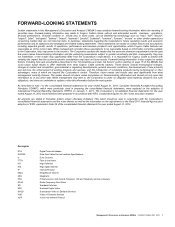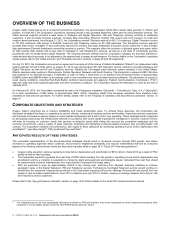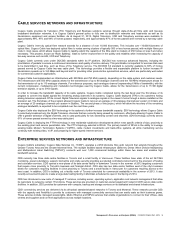Cogeco 2012 Annual Report Download - page 17
Download and view the complete annual report
Please find page 17 of the 2012 Cogeco annual report below. You can navigate through the pages in the report by either clicking on the pages listed below, or by using the keyword search tool below to find specific information within the annual report.16 COGECO CABLE INC. 2012 Management’s Discussion and Analysis (MD&A)
assessed at this time. Also, the capital and operating expenditures eventually required to offer quadruple-play service bundles and mobile
services may not be offset by the incremental revenue that such new bundles or mobile services would generate, thus resulting in downward
pressure on operating margins.
Cogeco Cable currently faces competition in its service areas mainly from a few large integrated electronic communications service providers.
The largest, BCE Inc. (“Bell”), offers through its various operating entities a full range of competitive voice, data and video services to
residential as well as to business customers in the Provinces of Québec and Ontario through a combination of fixed wireline, mobile terrestrial
wireless and satellite platforms. Bell is actively competing for television customers in the television distribution market not only with satellite
distribution but also increasingly with its fibre optic IPTV service TELUS Communications Company (“TELUS”) competes with all of Cogeco
Cable’s services in the Lower St. Lawrence area of the Province of Québec, through its own fibre optic IPTV service and wireline
telecommunications network, and with Cogeco Cable’s telecommunications services throughout Cogeco Cable’s footprint through its mobile
telecommunications network. However, Cogeco Cable’s Telephony service is provided with the assistance of certain TELUS carrier services
pursuant to a contractual arrangement. The agreement with TELUS is currently the subject of negotiations for a multi-year renewal. Shaw
Direct, the direct-to-home satellite service of Shaw Communications Inc. (“Shaw”), competes for television customers throughout Cogeco
Cable’s footprint. Rogers Wireless Communications Inc., a subsidiary of Rogers Communications Inc. (“Rogers”), operates a mobile
telecommunications network in Ontario and Québec and is the owner of the Inukshuk broadband wireless network in partnership with Bell.
Rogers Cablesystems Inc., the cable subsidiary of Rogers, is licensed to extend its services in the Burlington, Oakville and Milton areas, which
are part of Cogeco Cable’s footprint in Ontario, although there has not been any significant cable overwiring to date. Vidéotron Ltd.
(“Vidéotron”), an indirect subsidiary of Québecor Inc., offers competitive telecommunications services in Cogeco Cable’s Québec footprint and
is actively marketing its mobile telecommunications services in Québec. Other advanced wireless service mobile telecommunications service
operators, including Wind and Public Mobile, are also operating in the market in Ontario and Québec. The federal government has announced
that it will make additional spectrum available for advanced mobile telecommunications services across Canada through an auction process to
be held in 2013. As a result of this auction, competition in mobile telecommunications, including telephony and Internet access services, is
likely to increase further. This may lead to more attractive pricing and flexible service options, which may in turn cause increased substitution
between wireline and wireless telecommunications services, a phenomenon often referred to as “cord cutting”. Cogeco Cable also competes
within its network footprint with other telecommunications service providers, including third parties using Cogeco Cable’s own wireline network
facilities pursuant to its third party Internet access tariff.
Competition from Over-the-top (“OTT”) services such as Netflix, Google TV and Apple TV, is also rising in North America, with the resulting risk
that consumers may increasingly migrate to consumption of television content through their broadband connection rather than through their
traditional cable television subscription services, and consume less on-demand television content on the the VOD or SVOD platforms of cable
television service providers, a phenomenon often referred to as “cord shaving”. Revenue and margins derived from the Corporation’s HSI
access services may not entirely compensate for the eventual loss of revenue or margin derived from the Corporation’s Television services in
the future. Alternative voice and data communications services are also proliferating over the Internet, resulting in the risk that fragmentation
and disintermediation may also occur in the future with respect to the Corporation’s Telephony service.
CDS faces direct competition from a number of providers of business telecommunications solutions, data hosting and cloud computing service
providers, including Bell, Rogers, TELUS and MTS Allstream. These service providers offer services directly or through white label
partnerships for a similar suite of services to those offered by CDS. In the enterprise and mid-market segments, CDS competes on its data
centre offerings with Bell (directly and with Q9 recently acquired by Bell) and TELUS and in some cases data centre service providers like
Peer1, Primus and Savvis. CDS also faces competition from other managed IT providers like Sungard and smaller specialized firms. For its
managed IT and infrastructure services CDS is likely to also face some competition from larger integrators like IBM.
The level of piracy of television signals and the actual penetration of illicit reception of television distribution services in households within the
Corporation’s service areas may also have a significant effect on the Corporation’s business and the competitiveness of its service offerings.
TECHNOLOGICAL RISKS
The rapid evolution of telecommunications technologies is fuelled by a highly competitive global market for digital content, consumer
electronics and broadband products and services. The Corporation continues to monitor the development of technologies used for the
transmission, distribution, reception and storage of data and their deployment by various existing or potential competitors in the broadband
telecommunications markets.
There are now several terrestrial and satellite transmission technologies available to deliver a range of electronic communications services to
homes and to commercial establishments with varying degrees of flexibility and efficiencies, and thus compete with cable telecommunications.
On the other hand, cable telecommunications also continue to benefit from rapid improvements, particularly in the areas of modulation, digital
compression, fractioning of optoelectronic links, multiplexing, HD distribution, switched video distribution and ultra high speed passive optical
networks.
Management of the Corporation believes that broadband wireline distribution over fibre and coaxial cable continues to be an efficient, reliable,
economical and competitive platform for the distribution of a full range of electronic communications products and services. However,
competitive market forces drive the further deployment of fibre optic facilities right up to the user premises, both for business and residential
customers. The competitiveness of the cable broadband telecommunications platform will therefore continue to require substantial additional
capital investment on a timely basis in an increasingly competitive and uncertain market environment. In particular, additional capital
investment will be required over the medium term to transition fully the Corporation’s legacy wireline network to IP delivery for all services from
the head end to the customer, and to deploy increased capacity and speed in a more competitive marketplace.
As IP based traffic continues to grow very rapidly over the Corporation’s networks and new technology, systems, software and equipment is
deployed more quickly in order to manage this increased traffic, there is a growing risk of facing unexpected technical problems, with a
























